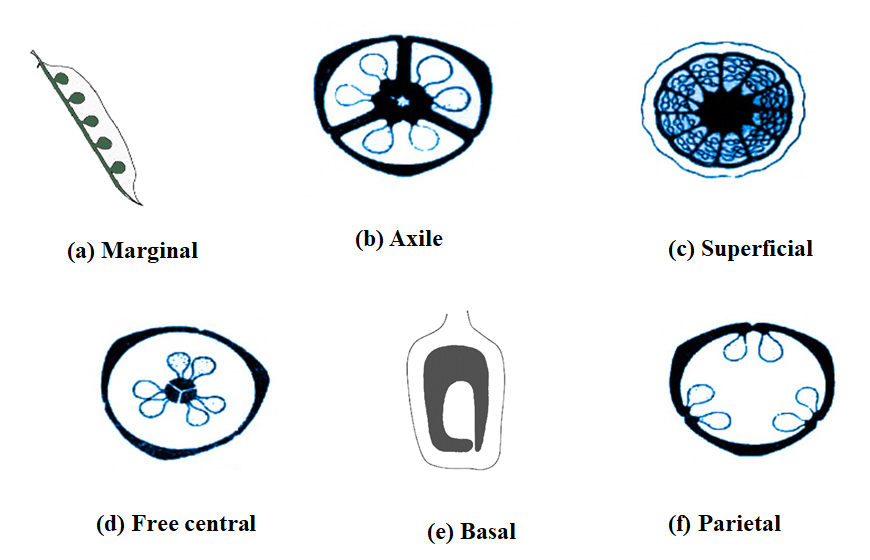Answer
328.6k+ views
Hint: Inside the ovary, the developing embryo derives all its nutrition and basic amenities from the parent body, so it remains connected to the ovary.
Complete answer:
Placentation is defined as the arrangement of the placenta in the ovary of a flower. The placenta connects the ovules with the wall of the ovary.
The types of Placentation are-
1. Marginal placentation- In marginal placentation, the placenta forms a ridge along the ventral suture of the ovary and the ovules develop on it making two separate rows. This type of placentation is found in pea plants.
2. Parietal placentation- In parietal placentation, the ovules remain attached to the inner walls of the ovary. It is found in cucumber, etc.
3. Axile placentation- In axile placentation, the placenta lies on a central axis and ovules are attached to it. The ovary is segmented by fibrous septa. It is found in China rose, lemon, and tomato.
4. Basal placentation- In basal placentation, the placenta develops from its base and a single ovule is found attached to the base. It is found in the Asteraceae family that consists of marigold, sunflower, etc.
5. Free central placentation- In free central placentation, the ovules are present on the central axis. There is no formation of septa. This type of placentation is found in Dianthus and primrose.
Note:
1. The ovules inside a flower's ovary are attached via funiculi, the plant part equivalent to an umbilical cord in human beings. The part of the ovary where the funiculus attaches is known as the placenta.
2. Placentation is meant for the transfer of nutrients, respiratory gases, and water from maternal tissue to the growing embryo, and also for the removal of waste from the embryo.
3. Some plants have a special type of placentation known as Superficial placentation where the ovules develop over the entire inner surface of the carpels. It generally occurs in a multicarpellary ovary, e.g., Nymphaea.

Complete answer:
Placentation is defined as the arrangement of the placenta in the ovary of a flower. The placenta connects the ovules with the wall of the ovary.
The types of Placentation are-
1. Marginal placentation- In marginal placentation, the placenta forms a ridge along the ventral suture of the ovary and the ovules develop on it making two separate rows. This type of placentation is found in pea plants.
2. Parietal placentation- In parietal placentation, the ovules remain attached to the inner walls of the ovary. It is found in cucumber, etc.
3. Axile placentation- In axile placentation, the placenta lies on a central axis and ovules are attached to it. The ovary is segmented by fibrous septa. It is found in China rose, lemon, and tomato.
4. Basal placentation- In basal placentation, the placenta develops from its base and a single ovule is found attached to the base. It is found in the Asteraceae family that consists of marigold, sunflower, etc.
5. Free central placentation- In free central placentation, the ovules are present on the central axis. There is no formation of septa. This type of placentation is found in Dianthus and primrose.
Note:
1. The ovules inside a flower's ovary are attached via funiculi, the plant part equivalent to an umbilical cord in human beings. The part of the ovary where the funiculus attaches is known as the placenta.
2. Placentation is meant for the transfer of nutrients, respiratory gases, and water from maternal tissue to the growing embryo, and also for the removal of waste from the embryo.
3. Some plants have a special type of placentation known as Superficial placentation where the ovules develop over the entire inner surface of the carpels. It generally occurs in a multicarpellary ovary, e.g., Nymphaea.

Recently Updated Pages
How do you arrange NH4 + BF3 H2O C2H2 in increasing class 11 chemistry CBSE

Is H mCT and q mCT the same thing If so which is more class 11 chemistry CBSE

What are the possible quantum number for the last outermost class 11 chemistry CBSE

Is C2 paramagnetic or diamagnetic class 11 chemistry CBSE

What happens when entropy reaches maximum class 11 chemistry JEE_Main

Calculate the volume occupied by 88 gram of CO2 at class 11 chemistry CBSE

Trending doubts
Fill the blanks with the suitable prepositions 1 The class 9 english CBSE

Difference between Prokaryotic cell and Eukaryotic class 11 biology CBSE

Difference Between Plant Cell and Animal Cell

Fill the blanks with proper collective nouns 1 A of class 10 english CBSE

What is the color of ferrous sulphate crystals? How does this color change after heating? Name the products formed on strongly heating ferrous sulphate crystals. What type of chemical reaction occurs in this type of change.

One Metric ton is equal to kg A 10000 B 1000 C 100 class 11 physics CBSE

Change the following sentences into negative and interrogative class 10 english CBSE

Net gain of ATP in glycolysis a 6 b 2 c 4 d 8 class 11 biology CBSE

What organs are located on the left side of your body class 11 biology CBSE



